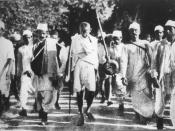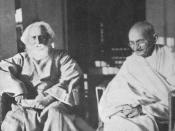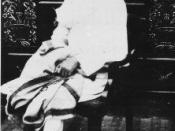The term satyagraha means "holding to the truth" or "truth force." Satyagraha became the means by which Gandhi struggled for equal political rights and did not harm or injure to their enemies. Gandhi insisted above all to follow nonviolence. "The force of truth, Gandhi felt, was not enough. The sword of satyagraha must be tempered with ahimsa or in other words, nonviolence. To the western world Gandhi held no real power by means of military strength or political office, nor did he have the advantage of great wealth. Yet his authority in India and the world was far-reaching. He held up the banner of satyagraha and marched with his "soldiers of peace" to realize a free India."(Gandhi Don Arthur Torgerson pg. 45)
At first Gandhian nonviolence (soul force) and violence (force by means of weapons) may seem opposite modes of political action. Paul F. Power, a professor of political science at the University of Cincinnati, notes that "the political action of violence was not always voluntary but necessary, dictating by the reason the state."(The
Meanings of Gandhi Paul F. Power pg. 195) However, Gandhi's optimism about human nature may lead us to wonder: how does nonviolence work?
The essential requirement of Gandhi rule of conduct was rejection of violence based on the virtue of the right intention. "When the intention was right, one can find ways and means of reducing physical violence in the practice of politics."(The Meanings of Gandhi Paul F. Power pg. 185) "On the other hand, Machiavelli, a Roman leader, was not denying the effectiveness of moral goodness, but he was denying its claim as a specific means of politics. He distrusted the dependability of human nature to do well. He believed that the man who makes professions of goodness amongst so many whom are evil would...


